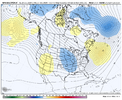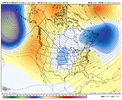Euro Weeklies and GEFS Extended both hold similar looks for each week from Jan 3-10 to Jan 15-22. Pretty unusual to see that consistency from these products with respect to both holding the look that long and with them being that similar. The magnitude of the anomalies weaken out in time with it being a long-range ensemble of members.
Those forecasts look like a blend of Dec-Mar from 69-70, 80-81, and 85-86. Chilly, but dry (not surprising). I'll take the chilly part though if we can get it and work on the dry part later.



























